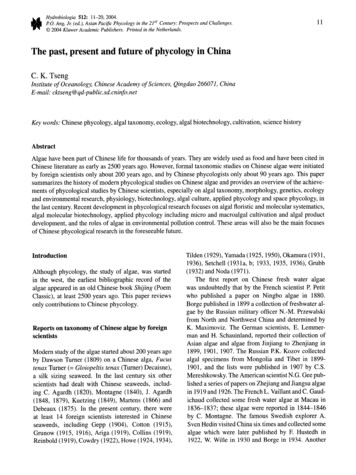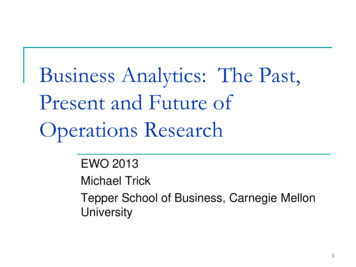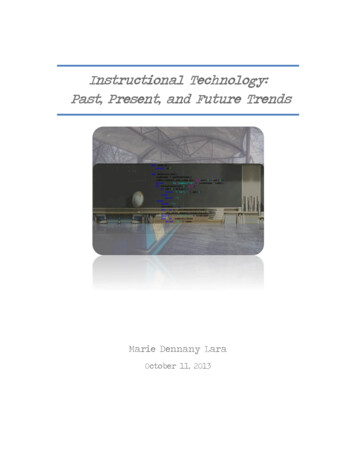
Transcription
Hydrobiologia 512: 11-20,2004.P.O. Ang, Jr. (ed.), Asian Pacific Phycology in the 21 st Century: Prospects and Challenges. 2004 Kluwer Academic Publishers. Printed in the Netherlands.11The past, present and future of phycology in ChinaC. K. TsengInstitute of Oceanology, Chinese Academy ofSciences, Qingdao 266071, ChinaE-mail: cktseng@qd-public.sd.cninfo.netKey words: Chinese phycology, algal taxonomy, ecology, algal biotechnology, cultivation, science historyAbstractAlgae have been part of Chinese life for thousands of years. They are widely used as food and have been cited inChinese literature as early as 2500 years ago. However, formal taxonomic studies on Chinese algae were initiatedby foreign scientists only about 200 years ago, and by Chinese phycologists only about 90 years ago. This papersummarizes the history of modern phycological studies on Chinese algae and provides an overview of the achievements of phycological studies by Chinese scientists, especially on algal taxonomy, morphology, genetics, ecologyand environmental research, physiology, biotechnology, algal culture, applied phycology and space phycology, inthe last century. Recent development in phycological research focuses on algal floristic and molecular systematics,algal molecular biotechnology, applied phycology including micro and macroalgal cultivation and algal productdevelopment, and the roles of algae in environmental pollution control. These areas will also be the main focusesof Chinese phycological research in the foreseeable future.IntroductionAlthough phycology, the study of algae, was startedin the west, the earliest bibliographic record of thealgae appeared in an old Chinese book Shijing (PoemClassic), at least 2500 years ago. This paper reviewsonly contributions to Chinese phycology.Reports on taxonomy of Chinese algae by foreignscientistsModern study of the algae started about 200 years agoby Dawson Turner (1809) on a Chinese alga, Fucustenax Turner ( Gloiopeltis tenax (Turner) Decaisne),a silk sizing seaweed. In the last century six otherscientists had dealt with Chinese seaweeds, including C. Agardh (1820), Montagne (1840), 1. Agardh(1848, 1879), Kuetzing (1849), Martens (1866) andDebeaux (1875). In the present century, there wereat least 14 foreign scientists interested in Chineseseaweeds, including Gepp (1904), Cotton (1915),Grunow (1915, 1916), Ariga (1919), Collins (1919),Reinbold (1919), Cowdry (1922), Howe (1924,1934),Tilden (1929), Yamada (1925,1950), Okamura (1931,1936), Setchell (1931a, b; 1933, 1935, 1936), Grubb(1932) and Noda (1971).The first report on Chinese fresh water algaewas undoubtedly that by the French scientist P. Petitwho published a paper on Ningbo algae in 1880.Borge published in 1899 a collection of freshwater algae by the Russian military officer N.-M. Przewalskifrom North and Northwest China and determined byK. Maximoviz. The German scientists, E. Lemmerman and H. Schauinland, reported their collection ofAsian algae and algae from linjiang to Zhenjiang in1899, 1901, 1907. The Russian P.K. Kozov collectedalgal specimens from Mongolia and Tibet in 18991901, and the lists were published in 1907 by C.S.Mereshkowsky. The American scientist N.G. Gee published a series of papers on Zhejiang and Jiangsu algaein 1919 and 1926. The French L. Vaillant and C. Gaudichaud collected some fresh water algae at Macau in1836--1837; these algae were reported in 1844-1846by C. Montagne. The famous Swedish explorer A.Sven Hedin visited China six times and collected somealgae which were later published by F. Hustedh in1922, W. Wille in 1930 and Borge in 1934. Another
12famous explorer, the Austrian H. Handel-Mazzetiecarne to China in 1913 and had also collected somealgae which were studied and published by H.Skujain his Symbolla Sinica in 1937. Other investigatorswere I.E. Tilden in 1920, Okada in 1932 and 1936,K. Negora in 1940, 1941, 1943 and 1953, Mashiko in1951 and M. Noda in 1963 and 1971. This brief discussion on the reports of foreign scientists on Chinesefresh-water algae is extracted from a report on the history of systematic classification of Chinese freshwateralgae by Professors Bi, Hu and Liu (Bi et aI., 2001)containing the necessary references.Modern study of phycology by Chinese scientistsModem study of phycology by Chinese scientists wasundoubtedly initiated by C.S. Chien (Professor QianChong Shu) who published a physiology paper in 1917on 'Peculiar Effects of Barium, Strontium and Cesiumon Spirogyra' (Chien, 1917). Professor H.H. Chungcarne back to China after some years of postgraduate study at Harvard University in U.S. Apparently,he took a course on algae at the Woods Hole MarineBiology Laboratory in the early twenties and becameinterested in phycology. In his trip to the vicinityof Xiamen and other places in Fujian, Guizhou andHubei Provinces, he collected not only vascular plantspecimens but also algal specimens including seaweeds and freshwater algae. He did not study the algalspecimens himself but sent them to Dr N.L. Gardner ofU.S. He even taught a course on a1g010gy at XiamenUniversity in 1929 in which I had the opportunity toattend.Taxonomic phycologyThe first Chinese to study taxonomic phycology inChina is Wang Chu-Chia (Prof. Wang Zhi-Jia) whopublished his first paper in 1930 (Wang, 1930), andaltogether 12 papers. The next one is Li Liang-Ching(Dr L.C. Li) who published in 1932 an abstract ofhis dissertation of Doctor's degree (Li, 1932), andaltogether 29 papers. The third phycologist is c.K.Tseng (Dr Zeng Cheng-Kui) who published his firstphyco10gica1 paper in 1933 (Tseng, 1933), and altogether, to date, 344 papers, of which 97 concernedtaxonomy and resources, and edited 12 books. Thefourth phycologist is Jao Chin-Chili (Dr Rao Qin-Zhi)who published his first paper on Chinese phycologyin 1935 (Jao, 1934), and altogether 76 phycologicalpapers and edited two books. The fifth phycologistis Nie Dashu (Prof. Ni Da-Shu), a protozoologistturning to a Dinophyta phycologist and published hisfirst paper in 1934 (Wang & Nie, 1934), and altogether 12 papers. Professor Nie eventually becamethe first Chinese specialist on aquatic animal diseases.The sixth phycologist is Chin Teh-Chiang (Prof. JinDe-Xiang) who was originally a zoologist and afterobtaining M.Sc. at Lingnan University in 1935 became interested in phytoplankton; he published hisfirst phycological paper in 1937 (Chin, 1937) and studied diatoms ever since, publishing 65 papers and fourbooks. The seventh phycologist is Chu Hao-Ran (ZhuHao-Ran), a former student of Dr Jao who publishedhis first paper in 1944 (Chu, 1944), and altogether 40papers and one book. The eighth phycologist is LeyShang-Hao (Prof. Li Shang-Hao), also a former student of Dr Jao, published his first phycological paperin 1944 (Ley, 1944), and altogether 9 papers and onebook.The above eight phycologists, including three marine and five freshwater phycologists, were practicallythe few scientists devoted to the study of algae before 1949 who continued their studies of taxonomicphycology after 1949. After the establishment of thePeople's Republic of China, the Chinese people especially people of the coastal provinces, pay moreattention to the algae and a few universities even offercourses in phycology. Many scientists are involved inthe study of different phases of algae. In taxonomicstudy of the algae, we may mention just a few, such asProfs Chiang Young-Ming of Taiwan and Fan KungChu of mainland China, both students of the late DrGeorge Papenfuss of U.S., Profs Zheng Bo-Lin, ZhangJun-Fu, Xia Bangmei and Lu Baoren, students of DrC.K. Tseng, Prof. Bi Lie-Jiao, a student of Dr c.c.Jao.As is in the other botanical and zoological sciences, taxonomy always preceeds other sciences. Atotal of 40000 specimens of marine algae and 30000specimens of freshwater algae have been collected respectively by the Institute of Oceanology and Instituteof Hydrobiology of the Chinese Academy of Sciences(CAS) alone. The publication of the CryptogamicFloras of China started in the seventies, consistingof five floras (1) Marine algal flora, (2) Fresh water algal flora, (3) Fungal flora, (4) Lichen flora and(5) Mosses and Liverworts flora. The algal flora wassplit into two because persons involved and collecting methods in these studies are different from oneanother. In the marine algal flora (Flora Algarum Mar-
13inarum Sinicarum) two volumes have been published:Vol. 2, Rhodophyta, No.5 Ahnfeltiales, Gigartinalesand Rhodymeniales by Xia & Zhang (1999) describing 17 families, 40 genera and 104 species; and Vol.3, Phaeophyta No. 2 Fucales by Tseng & Lu (1999)describing 3 families, 6 genera and 141 species. Twomore volumes on Ceramiales (Rhodophyta) by ZhengBo-Lin et al. and on Centricae (Bacillarophyta) byGuo Yu-Jie are in the process of editing and will beready for printing soon. In the fresh water algal flora(Flora Algarum Sinicarum Aqua Dulcis) six volumeshave already been published: Vol. 1, Zygnemataceaeby c.c. Jao (1986); Vol. 2, Chroococcophyceae byH.R. Chu (1991); Vol. 3, Charophyta by Han Fushan& Li Yaoying (1994); Vol. 4, Centric diatoms by QiYuzao (1995); Vol. 5, Ulothricales, Ulvales, Chaetophorales, Trentepohliales and Sphaeropleales by LiShang-Hao & Bi Lie-Jiao (1998); and Vol. 6, Euglenophyta by Shi Zhixin (1999). Two more volumes arein the process of being edited, and will be ready forprinting soon.Basic study on morphology, ecology and physiologyofthe algaeAlgal morphologyTseng & Chang (1954, 1955) started their investigation on the life history of Porphyra tenera Kjellman inearly 1952, independent of Kurogi of Japan and solvedthe problem of the 'seed' of Porphyra in its cultivation. This they called 'conchospore' which has beenfollowed by most phycologists. In the eighties, Tseng& Sun (1989) studied the chromosome numbers of theConchocelis stage of Porphyra and the alternation ofthe nuclear phases and chromosome numbers. Theyrevealed the astonishing phenomenon that meiosis occurs in the germinating conchospores (Tseng & Sun,1989).Algal ecologyThe most difficult job in algal ecology takes placein marine expeditions. One has to collect the specimens of phytoplankton by special devices, to analyzethe collected specimens, to identify them and to writeout reports. Algal ecological work actually started in1954 when we initiated fishery expedition under theichthyologist Professor Zhang Xiao-Wei and the ecological group was led by Dr Zhu Shup-Ping with GuoYu-Jie as his assistant. The population was analyzedand the ecological characteristics of the dominatedspecies decided. This was followed by national ocean-ological expeditions (1958-1962), coastal zones andbeaches investigation (1981-1986), islands investigation (1990-1992), and Xisha and Nansha Islandsexpeditions (1980-1999). In these studies, Guo wasin charge of the phytoplankton study. She contributeda paper on the primary productivity and phytoplanktonof the Kuroshio (YJ. Guo, 1991). She believed that theKuroshio area was one of the unproductive regions inthe world oceans, although it was a little more productive than the regions near the Equator. In a studyof the characteristics of phytoplankton distribution inthe Yellow Sea, Guo & Zhang (1996) pointed out thatthe horizontal and vertical distribution patterns of thephytoplankton in the Yellow Sea in May and September in 1992 were similar but the average abundanceand species number of phytoplankton in Septemberwere higher than those in May. Diatoms dominatedthe 142 species of phytoplankton identified.Since the seventies, our scientists paid special attention to marine pollution ecology, especially theecology of red tides. On the ecological dynamics ofthe red tide, it was found that between Noctilucascintillans (Macartney) Ehrenberg and Skeletonemacostatum (Grev.) Cleve, Prorocentrum minimum (Pavilard) Schiller and Skeletonema, there was in existence a definite interspecific competition and that theappearance of different red tides was related to the NIPratio (Zou, 1999). Investigation on the poisonous substance present in shellfish may indicate the distributionof the poisonous algae (Zhou et aI., 1999).Gymnodinium mikimotoi Miyake et Kominami exOda was one of the principal red tide organisms inthe red tide occurring in Hong Kong and GuangdongProvince, resulting in the death of many aquaculturefish in 1998 (Qi et aI., 2004). An investigation wasconducted by Jinan University on the mechanism ofthis Dinophyte on the fish and found out that this Dinophyte can cause swelling on the upper skin tissue ofthe fish gills. This resulted in the complete obstructionof the gills, leading to the death of the fish.Algal physiologyIn the early forties when C.K. Tseng worked on aspecial agar project, he initiated a study of the photosynthesis of Gelidium cartilagineum (L.) Gaillon andpublished a paper in 1946 (Tseng & Sweeney, 1946).In the sixties a study was made on the pigment system and photosynthesis of Porphyra yezoensis Ueda(Zhou et aI., 1966). Unfortunately the researches hadto stop in late 1966 because of the so-called 'CulturalRevolution'. The work was resumed in 1973, and a
14comparative study of the spectrum absorption of somespecies of green, brown and red seaweeds was madeand published in 1974 (Zhou et aI., 1974). A seriesof papers on comparative photosynthesis of benthicseaweeds was published by Tseng et aI. (1980, 1981a,b). The discovery of Prochloron in the Xisha (Paracel)Islands (Zeng et aI., 1982), led us to discussion on theevolution of photosynthetic organisms (Tseng & Zhou,1983a, b; 1984).Algal geneticsTalking about algal genetics, we must pay due respectto the late Prof. T.C. Fang (Fang Zong-Xi), the founderof this science in China. Fang was trained as a human geneticist in England and returned to China in1950. In 1953, he accepted the invitation of Shandong University, then in Qingdao, and joined the staff.Later in 1959 when the Shandong University movedto Jinan, he stayed and joined the staff of ShandongCollege of Oceanography. He was invited by the Institute of Oceanology, CAS, to be a part-time researchfellow and in charge of genetic research. He usedthe cultivated Laminaria as the main subject for genetic research. In 1959, the principal problems of thecultivation of Laminaria japonica Aresch. had beensolved and large-scale cultivation had just started.The problems concerning genetics of the Laminariabecame significant. The Laminaria employed is thewild natural population, rather than selected strains.However, Laminaria has sexual reproduction. In thespore collecting process, two or more plants wereused. The resulting sporophytes were a mix of thosefrom hybridization and those from a single plant selffertilization. Fang made an experiment with both andshowed that hybrid sporophytes exhibited a two timesfaster in growth in area than those obtained from selffertilization (Fang & Jiang, 1962).From 1959-1984, Fang and his students at theInstitute of Oceanology, CAS and the Shandong College of Oceanology conducted 25 years of geneticalresearch on Laminaria and later also on Undaria.On the conviction that the cultivated Laminaria is ahybrid, they employed self-fertilization to produce afew new strains of Laminaria, such as the broad leafstrain 'Haiqing No.1', the long leaf strain 'HaiqingNo.2', and the thick leaf strain 'Haiqing No.3'. Theyobtained clones of male and female gametophytesand discovered that parthenogenetically developed female gametophytes gave rise to female sporophyteswhich produced zoospores that grew to become femalesporophytes (Fang & Dai, 1984).The Shandong College of Oceanography, in cooperation with Rongcheng Laminaria Seedling Station and Rongcheng Aquaculture Station, used a selected female gametophyte to cross with the malegametophyte from a thick frond sporophyte and obtained a new strain called 'Danhai No.1' which gavea higher yield and better quality than the best varietyused in cultivation at that time (Fang et aI., 1983).In 1981, Fang and his group employed the hybridbetween the female haploid clone No. 10 and themale haploid cell introduced from Hokkaido, Japan.A new strain was obtained, the 'Danza No. 10', whichwas estimated to increase the yield by 30% (Fanget aI., 1985). The bountiful Laminaria harvest becamea reality and this must be partially credited to Prof.Fang.Studies on microalgae, biotechnology and spacephycologyMicroalgaeIn the fifties, the investigation on feeding marine juvenile aquatic animals with some microalgae such asTetraselmis, Phaeodactylum, Pavlova was carried out.The animal growers were provided with the seeds ofthese algae and instructions for their cultivation. Inthe early sixties, cultivation of the freshwater algaChlorella sp. in large scale was tried but failed. Inthe eighties, the brine alga Dunaliella was started tobe cultivated in large scale and Dunaliella cultivationis now an established industry (Guo, 1991). In theseventh five-year plan, one of the problems was todecrease the dependence of aquaculture on importedfish protein. It was decided to study three microalgae because of their high protein contents, namely,Dunaliella, Anabaena and Spirulina. It was foundthat Spirulina gave the best and most proteinaceousproducts. It was further found that Spirulina is anexcellent health food for humans (Wu et aI., 1993).During the following years, there had been a Spirulina'fever' in Chinese society and more than 100 enterprises were involved in Spirulina production. Thereare now still quite a few enterprises producing tabletsfor human consumption (Liang et aI., 2004).BiotechnologyBiotechnology has been effected in marine algae inthe following six categories: (1) In hybridizationtechnique, hybrids of Laminaria japonica have beenobtained. (2) In cellular and protoplast technique, cultivation of Porphyra haitanensis Chang et Zheng has
15been effected with vegetative cell; growth of isolatedseaweed protoplast of Vlva, Enteromorpha, Monostroma, Porphyra and Chondrus has been obtained.(3) Algal immobilization technique has been attempted for seedstock and seedling production. (4) In tissueculture technique, tissue cultures of Laminaria japonica and Vndaria pinnatifida (Harv.) Sur. have beeneffected. (5) In processing of natural products, including bioactive substances, some work on anti-tumorand anti-radiation effect of marine algae has been doneand the hypolipodermis medicine PSS from Laminariajaponica has been awarded golden medal in the 15thInternational Fair of Invention in Yugoslavia. (6) Inbiotechnology industry, we have promoted mass cultivation of Dunaliella for the -carotene and that ofSpirulina for its high protein content (Tseng & Qin,1991).Space phycologySpace biology is quite a new thing in China, especially space phycology for which we have to thankthe Institute of Hydrobiology, Chinese Academy ofSciences. A good discussion of this research is foundin Liu et al. (2001). In the Chinese Journal of SpaceScience, Vol. 17, supplement 1997, several paperswere published by Prof. YD. Liu and his colleagues.In there, Prof. Liu and his colleagues summarizedthe interesting points about microgravity biology,space physiology, cell culture and tissue engineering,space exploitation and some details concerning gravisensing (Hu & Liu, 1997a, b; Song et aI., 1997). Theyfound in the flight experiment that in Chlorella pyrenoidosa Chick the number of pyrenoides conspicuouslydiminished and in Anabaena its fat body significantlydecreased in size. Their experiments on Anabaenaoryza Fritsch strains retrieved from space flight andreflight indicated two types of biological responses,the recoverable phenotype responses and the heritable genotype responses (Hu et aI., 1996; Hu & Liu,1997c). Their study of a strain of the microalga Anabaena carried in the retrievable canister for 15 daysshowed that the growth rate of the alga was slowerthan that of the ground control (Hu et ai., 1997). Inanother experiment, nine species of algae were flownin space for eight or fifteen days, then retrieved andanalyzed in the laboratory (Hu & Liu, 1997b). Theresults indicated that the algae have a strong adaptability to space environment. Cytological observationon Anabaena siamensis Antarikanonda after spaceflight showed obvious difference between the spaceflight and the ground control samples (Chen et ai.,1997). The possible mechanisms of responses ofDunaliella salina (Dunal) Teodoresco to simulatedmicrogravity showed the plasma membrane to be themost direct site of paraperception and a theoreticalmodel for micro-gravi-sensing, transduction and responses of the organism was proposed (Hu & Liu,1997d).Applied studies on cultivation ofseaweeds and theseaweed industryCultivation of algaeCultivation of seaweeds by traditional methods, to theknowledge of the author, dealing with Gloiopeltis andPorphyra has been in existence in China for severalhundred years. Modem methods of cultivation are,however, only about forty something years old. Raftsin various forms are generally applied. Three kinds ofmethods are practiced.Zoospores method, the Laminaria type ofmaricultureThe zoospores of Laminaria or Vndaria are collectedand cultured. Laminaria japonica is a cold temperate alga and can survive in summer water temperatureof 20-25 C, but cannot survive in temperature above25 C for a long time. We have devised a summersporeling method in which zoospores are collected inearly June, the gametophyte and young sporophytestages pass the hot summer in cooled rooms of 10 C,and the young sporophytes are taken out to the sea inAutumn when water temperature gets down to 20 C.The summer sporeling method is very suitable for cultivation of cold temperate plants in warm temperate oreven subtropical regions (Tseng et ai., 1955; Tseng,1981).Conchospore method, the Porphyra type ofmaricultureThis is especially applicable for the cultivation ofpurple laver, Porphyra spp. The leafy Porphyra isthe object of cultivation. Carpospores from Porphyraare planted on mollusc shells in late Spring. The carpospores will penetrate into the shell and develop thefilamentous sporophyte stage - the conchocelis stage.This will eventually give rise to conchospores whichupon germination will grow to become the leafy Porphyra (Tseng & Chang, 1955; Tseng, 1981). Thefilamentous thalli of Bangia jusco-purpurea (Dillw.)Lyngb. are also cultivated by this method.
16Vegetative multiplication method, the Betaphycustype ofmaricultureThis is applicable to quite a few species of seaweedsbeside Betaphycus, such as Gracilaria, Kappaphycus and Hizikia ( Sargassum fusiforme (Harv.)Setch.). Carpospores of Gracilaria lemaneiformis(Bory) Daws. upon germination will give rise to acallous like structure which will have to take abouthalf a year to grow up to become young sporelings andanother half year to grow to become an adult plant. Forpractical purposes, the growth rate is too slow. In thevegetative multiplication method, cuttings of Gracilaria are planted on raft during the best season for theirgrowth and they grow to 100-200 times their originalthallus in weight in one season. In the case of Gelidiumand Hizikia, very young plants are employed.Fertilizer application and Laminaria transplantationto the southIn the cultivation of Laminaria, a method of applyingfertilizer in the open sea was devised (Tseng et aI.,1955b). Southward transplantation of Laminaria toZhejiang and Fujian Provinces of the East China Sea,which is subtropical in nature has been conducted withsuccess (Tseng, 1958). With the help of the summerspore1ing method, the height of the hot summer temperature and the duration of hot summer are not ofmajor concerns. Rather, it is the length of the winterand spring seasons that is important, i.e. whether theseasons are long enough to effect growth of the plantto market size. By this way, the cold temperate Laminaria japonica is now maricultured in warm temperateand subtropical regions such as Zhejiang and Fujian(Tseng, 1981).Current algal cultivation industryAt present two species each of Porphyra and Gracilaria, and one species each of the following: Bangia,Gelidium, Kappaphycus, Betaphycus, Laminaria, Undaria and Hizikia ( Sargassumfusiforme) are undercultivation by the above methods of mariculture.There is also a small microalgae cultivation industry, a Dunaliella and a Spirulina mariculture industry. The Dunaliella culture group is located inTanggu, Tianjin, a part of the Salt Research Institute, which received funding from the United NationDevelopment Programme (UNDP). This produces carotene present in the cells in as much as 6% of thedry weight (Guo, 1991). The Spirulina culture groupis located in Sanya, Hainan Province in south China.It belongs to the South China Sea Institute of Oceano-logy. Spirulina is well known for its protein contents,60-70% of the plants in dry weight (Wu et al., 1993).There are about 50 Spirulina culture groups in China,mostly freshwater, producing altogether less than 1000tons of Spirulina powder per year.Marine algal industryAt present China has an alginate industry composed ofa few factories and employing Laminaria japonica asthe principal raw material. The alginate was used asa substitute for starch grains in sizing cotton fibers inQingdao and a small factory was built for the production of sodium alginate. It is now popularly employedin textile industry and produced about 8000-10000tons of the alginate annually. The industry was initiated in the early fifties employing wild Sargassumconfusum Ag. as the raw material (Tseng & Ii, 1962).In a few years resources of the raw material werepractically depleted. So the industry had to tum tothe cultivated Laminaria, which is more expensive butdependable as a raw material.China has a small agar industry dating back to thethirties. There has been a small agar factory in Qingdao employing Gelidium amansii (Larnx.) Lamx. asthe raw material. There are now a few small factories in Fujian Province employing over-mature thalliof Porphyra haitanensis as raw materials and a fewsmall factories in Guangdong and Hainan Provincesemploying Gracilaria tenuistipetata var. liui Zhang etXia as raw material. Total annual production of agar atpresent is only a few hundred tons.China has also a small carrageenan industry witha small factory in Hainan. For many years this factoryemployed locally produced Betaphycus gelatinum (Esper) Doty as the raw material and produced a productcalled 'agar' in the market. It is actually a carrageenaninstead of an agar. The annual production is also a fewhundred tons.The future of Chinese phycologyTaxonomy and floristic studyChinese phycology has started rather late in the 1930s.Compilation of Chinese algal floras, although plannedin the early seventies, did not get the actual publication started until the eighties. The first volume,Tomus 1 of Floras Algarum Sinicarum Aqua Dulcis, Zygnemataceae is by Dr Chin-Chih lao. Atpresent, six volumes have been published in this
17series. In the Flora Algarum Marinarum Sinicarumtwo volumes have been published. Four volumesof these two series have just finished compilationand are in the process of being edited. Fourteenmore volumes in these two series of algal floraswill be compiled in the next few years. Preparation for the other algal groups, mostly microscopicand uncommon species, will follow. Studies on soilalgae, desert algae, snow algae and hot spring algaeshould be encouraged.Ecological studyPhytoplankton in terms of nannoplankton and thesmaller picoplankton have received careful studies forthe last forty something years. A few years ago, DrJiao Nian-Zhi found the picoplankton Prochlorellain the Pacific. This picoplankton was found in greatquantity below 100 m of sea water. Recently it wasalso found in the South China Sea. We are actuallyunaware taxonomically just how many genera and species of Prochlorophyte there are. The only way to findout is to keep on investigating. But it will involve alot of expenses for ship times and instrumentations.Survey of deep lakes should also be taken. I believewe shall find similar picoplankton. Since the seventies,algal ecological study in terms of the environment hasbecome more and more important.China's marine environment has been troubledmore and more with red tides and ways and means topredict and prevent the occurrence of red tides are becoming more and more important. We must protect ourseas from pollution. In the fifties when we promotedcultivation of seaweeds, we had to fertilize our seasbecause there was then a very low Nand P content. Butnow with the advance of animal aquaculture, the NandP contents in seawater have risen greatly. It is therefore suggested that large perennial seaweeds shouldbe planted to help absorb these excess nutrients andlarge scale cultivation of seaweeds could be carriedout for the same purpose to protect the environment(Fei & Tseng, 2003). With the development of spacetechnique, space phycology must be emphasized.Biotechnology studyEmphasis should be laid on molecular biotechnologyof seaweeds, referring to the biotechnology on identification, modification, production and utilization ofseaweed molecules, not only manipulating macromolecules such as DNA, RNA and proteins, but alsodealing with low molecular weight compounds such assecondary metabolites. Studies on molecular geneticlabeling techniques and genetic engineering should bemade (see Qin et aI., 2004).Comparative photosynthesis and evolutionPhotosynthetic pigments of the algae are much morecomplicated than those of the seed plants, especially the phycoerythrin and phycocyanin, which arenot found in the seed plants. Comparative photosynthesis of the algae with different photosyntheticpigments will show many things, especially the courseof evolution. It is therefore suggested that studies oncomparative photosynthesis should be continued.Cultivation of algaeIt may be said that modem seaweed cultivation hasstarted in China in the early fifties wh
papers and one book. The eighth phycologist is Ley Shang-Hao(Prof. Li Shang-Hao), also a former stu dent ofDr Jao, published his first phycological paper in 1944 (Ley, 1944), and altogether 9 papers and one book. The above eight phycologists, including three ma











